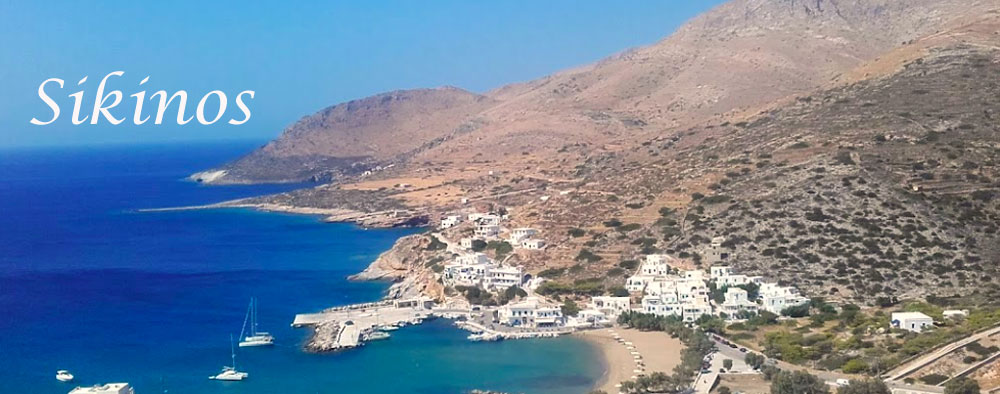Information about the island of Sikinos
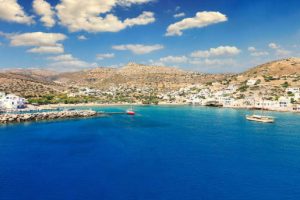
The people of Sikinos generously offer their love and smiles to strangers, embracing an endless appetite for playful banter, feasts, and celebrations. They are simple, warm, and welcoming, still embodying the authentic Cycladic hospitality. One of Sikinos’ distinctive features is its 61 chapels and six Byzantine churches adorned with frescoes from the 13th and 14th centuries.
Sikinos boasts minimal beaches, small in size, with crystal-clear blue-green waters. Retaining their “pristine” character, some are nestled in small coves, others hidden behind rocky islets, and a few tucked beneath steep cliffs. Most of the island’s beaches can be reached by boats departing from Alopronia, offering free umbrellas and sunbeds provided by the municipality.
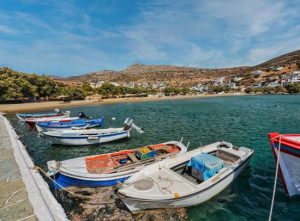
This tiny island remains untouched by modern civilization, preserving its authentic beauty, providing travelers with an unexpected journey filled with unique experiences, where tradition and nature harmoniously intertwine. During winter and spring, the island’s northern side transforms into a rare botanical garden with its ancient paths adorned by wildflowers.
The Chora of Sikinos, situated on the edge of a steep cliff, comprises two traditional settlements facing each other: the Castle, an old fortified authentic village dating back to the 15th century, and the Village. The whitewashed houses, preserving their original traditional architecture, along with cobblestone streets, churches, and remnants of windmills, faithfully maintain the island’s distinctive character.
In Sikinos, time appears to have halted. This small, unexplored, and authentic island encourages a unique perception of holidays, drawing visitors closer to unadulterated nature while keeping its traditional charm intact.
[ez-toc]
Mythology
According to mythological accounts, Sikinos Island has a rich and fascinating origin story. One version of the myth involves Thoantas, the mythical king of the Lemnian raiders and the progenitor of the Sicinians, who was the son of Dionysus, the god of wine, and Ariadne, the daughter of King Minos. Thoantas was sent to Lemnos by Rhadamanthys, a legendary figure associated with Minos, to protect Minoan interests in the northeastern Aegean region.
On Lemnos, Thoantas married a woman named Myrina, and together they had a daughter named Ypsipyli. The capital of Lemnos, Myrina, was named after Thoantas’ wife. It is believed that Thoantas established a lineage on the island, and his descendants came to be known as the Sicinians. This connection to Dionysus, the god of wine, is significant because Sikinos Island has a long history of wine production, which is considered one of its oldest and most important characteristics.
It should be noted that there are variations in the myth regarding Thoantas’ fate. Some versions suggest that Thoantas did not escape the massacre that took place on Lemnos, while others propose that he managed to flee to either Chios or Taurida (Crimea). Apollonius of Rhodes, as the director of the Alexandrian Library, was aware of these different versions and chose to associate the myth with Sikinos Island.
The decision to link Sikinos Island with Thoantas might have been influenced by the island’s prosperity during the reign of the Ptolemies of Egypt. At the time when Apollonius wrote about Sikinos, the Ptolemies were actively promoting their direct association with Dionysus, which could have influenced the choice of incorporating Thoantas’ myth into the island’s narrative.
Overall, the mythological origins of Sikinos Island revolve around Thoantas, his connections to Dionysus and Ariadne, and the establishment of a lineage on Lemnos that eventually led to the Sicinians, who named the island Sikinos in his honor. The island’s association with wine production further reinforces its mythical heritage.
History
Sikinos Island has a rich history that spans several centuries. The earliest known human presence on the island dates back to the Neolithic period, as archaeological findings suggest. Throughout its history, Sikinos has been inhabited by various civilizations and has experienced the influences of different cultures.
During the ancient Greek period, Sikinos was part of the Cycladic civilization and had connections with the Minoan civilization of Crete. The island was likely involved in maritime trade and had contacts with neighboring islands and mainland Greece. Sikinos also had its own independent city-state and minted its own coins.
In the 6th century BC, Sikinos, along with other Cycladic islands, fell under the dominion of the Athenian Empire. This period saw the island coming under the influence of Athenian politics and culture. It later became part of the Macedonian Empire after the conquests of Alexander the Great.
During the Hellenistic and Roman periods, Sikinos maintained its importance as a strategic location in the Aegean Sea. It continued to be part of larger political entities, including the Ptolemaic Kingdom of Egypt and the Roman Empire. The island prospered economically and became known for its agricultural products, such as wine, which enjoyed popularity in the region.
In subsequent centuries, Sikinos, like other Cycladic islands, faced the challenges of invasions and pirate raids. It came under the control of the Byzantine Empire and later the Venetians, who built fortifications to protect the island. The Ottoman Empire gained control over Sikinos in the 16th century, and it remained under Ottoman rule until the Greek War of Independence in the 19th century.
Following Greece’s independence, Sikinos became part of the modern Greek state. Like many other Greek islands, it experienced emigration as residents sought better economic opportunities abroad. Today, Sikinos is a peaceful and picturesque island that attracts visitors with its traditional charm, beautiful beaches, and preserved Cycladic architecture.
The island’s history is reflected in its archaeological sites, including ancient settlements, fortifications, and remnants of its past civilizations. Additionally, Sikinos has preserved its local traditions and customs, offering a glimpse into its cultural heritage.
Economy of the Sikinos
-
Tourism
Tourism is the main economic driver for Sikinos. The island attracts visitors with its picturesque landscapes, charming traditional villages, and beautiful beaches. Although not as popular as some of the neighboring islands like Mykonos or Santorini, Sikinos offers a quieter and more relaxed atmosphere, appealing to those seeking a tranquil getaway. Tourists enjoy exploring the island’s historic sites, such as the ancient acropolis and the monastery of Zoodochos Pigi. The local economy benefits from accommodation services, restaurants, cafes, and souvenir shops catering to tourists.
-
Agriculture
Sikinos has a long tradition of agriculture, with terraced fields covering its hillsides. The fertile soil and favorable climate support the cultivation of various crops, including grapes, olives, figs, and vegetables. Local farmers produce traditional products like wine, olive oil, honey, and herbs. Some of these products are sold locally, while others are exported to other regions of Greece.
-
Fishing
As an island, fishing plays a significant role in Sikinos’ economy. Local fishermen rely on the rich marine resources surrounding the island. Fishing activities provide a source of income for the fishing community and supply fresh seafood to local restaurants and markets.
-
Traditional crafts
Sikinos has a rich cultural heritage, and traditional crafts play a role in the local economy. Local artisans produce handmade products such as pottery, textiles, and woven goods, reflecting the island’s cultural traditions. These crafts are often sold to tourists as souvenirs or exported to other markets.
-
Services and small businesses
The island supports a range of services and small businesses that cater to both residents and tourists. These include grocery stores, bakeries, cafes, bars, and local shops. Additionally, the island’s infrastructure requires services like construction, transportation, and maintenance, providing employment opportunities.
It’s important to note that the size and scale of Sikinos’ economy are relatively small compared to larger tourist destinations. The island’s charm lies in its peaceful atmosphere and preserved traditions, which attract a niche group of tourists seeking an authentic Greek experience.
Getting around Sikinos
Sikinos is a small and beautiful Greek island in the Cyclades archipelago. Despite its small size, there are a few options for getting around the island. Here’s how you can move around in Sikinos:
-
Walking: Sikinos is a compact island with picturesque villages and stunning landscapes, making it ideal for exploring on foot. Walking allows you to fully immerse yourself in the island’s beauty and discover hidden gems along the way.
-
Bicycles: Renting a bicycle is another popular option for getting around Sikinos. Biking gives you the freedom to explore at your own pace while enjoying the scenic views. You can rent bicycles from local rental shops or inquire at your accommodation.
-
Local Buses: Sikinos has a bus service that connects its main villages and popular destinations. The bus schedule may be limited, especially during the low season, so it’s essential to check the timetable in advance. Bus tickets can be purchased on board.
-
Taxis: Taxis are available on Sikinos, and they can be a convenient mode of transportation, especially if you’re traveling with luggage or have limited mobility. However, keep in mind that there might be a limited number of taxis on the island, so it’s advisable to book in advance or inquire at your accommodation.
-
Private Transfers: Some accommodations offer private transfers to and from the port or other locations on the island. If you prefer a more personalized and hassle-free transportation option, you can arrange for a private transfer in advance.
It’s worth noting that Sikinos is a relatively small island, and the distances between its villages and attractions are not significant. However, the island’s terrain can be hilly and rugged, so it’s essential to wear comfortable shoes and carry water with you, especially if you plan on walking or cycling.
As always, it’s a good idea to check with locals or your accommodation provider for the most up-to-date information on transportation options and any specific recommendations for getting around Sikinos during your visit.
Villages of Sikinos
While it is not as well-known as some of its neighboring islands like Santorini or Mykonos, Sikinos offers a charming and authentic Greek experience. The island is known for its picturesque villages that showcase traditional Cycladic architecture and offer breathtaking views of the Aegean Sea. These villages on Sikinos provide visitors with an opportunity to experience the slow pace of island life, explore ancient ruins, enjoy traditional Greek cuisine, and take in the natural beauty of the island.
Chora
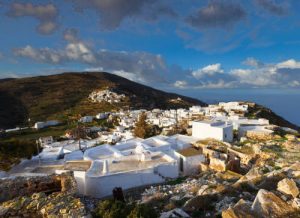
The Chora of Sikinos is known for its tranquility and authenticity, as it has remained relatively untouched by mass tourism. Visitors can wander through the labyrinthine alleys, admire the traditional Cycladic architecture, and discover hidden squares and local tavernas.
One of the main attractions in Chora is the Church of Pantanassa, a beautiful whitewashed church with a blue dome that stands prominently in the village. Inside the church, visitors can observe intricate religious iconography.
The Chora also features several small shops, cafés, and restaurants where visitors can enjoy local delicacies and relax in the peaceful atmosphere. It’s worth noting that Sikinos, including its Chora, has a slower pace of life compared to some of the more popular tourist destinations in the Cyclades.
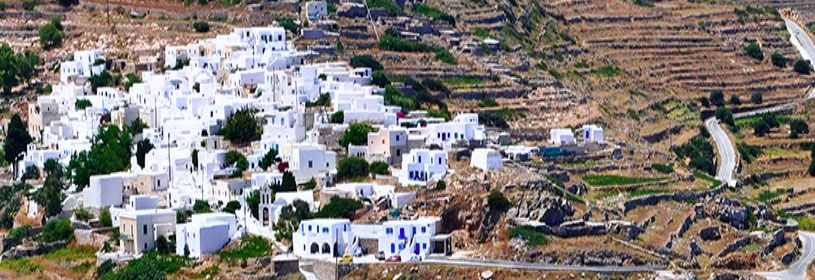
Kastro
The village of Kastro is characterized by its traditional Cycladic architecture, with whitewashed houses, narrow alleys, and blue-domed churches. It is a charming and well-preserved village that exudes a sense of history and tranquility. Walking through the labyrinthine streets of Kastro is like stepping back in time, as the village has maintained its traditional character over the years.
Within Kastro, you can explore its narrow streets, visit the churches, and enjoy the serene atmosphere. The village is home to several churches, including the Church of Pantanassa, which dates back to the 17th century and features beautiful frescoes. The Church of Agios Ioannis is another notable religious site in Kastro.
From Kastro, you can also take in breathtaking views of the surrounding landscape and the sparkling blue waters of the Aegean Sea. The village is perched high above the sea, providing a vantage point for enjoying the natural beauty of Sikinos.
Although Kastro is the main village on Sikinos, the island itself is relatively small and has a population of around 200 residents. Sikinos is known for its tranquility and peacefulness, making it an ideal destination for those seeking a relaxing getaway away from the crowds.
Overall, Kastro village in Sikinos is a charming and picturesque place that offers a glimpse into traditional Cycladic life. Its whitewashed houses, narrow streets, and panoramic views create a captivating atmosphere for visitors to enjoy.
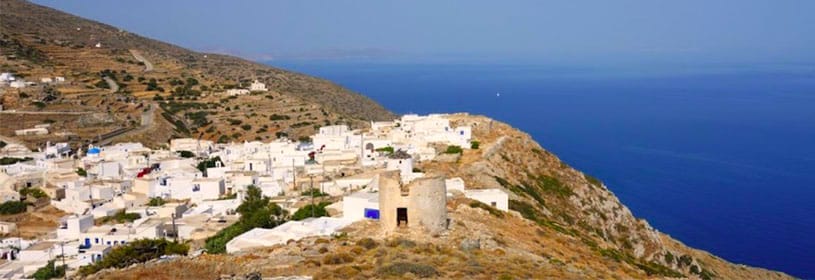
Alopronia
Alopronia is the main port of Sikinos and the entry point for visitors arriving by ferry. While it is not as picturesque as Chora or Kastro, it offers a peaceful and relaxed atmosphere. Alopronia has a sandy beach, a few tavernas, and accommodations for tourists.
In Alopronia, you will find a picturesque harbor with tavernas, cafes, and shops. The village has a charming, laid-back atmosphere and offers beautiful views of the sea. It is a popular spot for tourists to relax, enjoy the local cuisine, and explore the island.
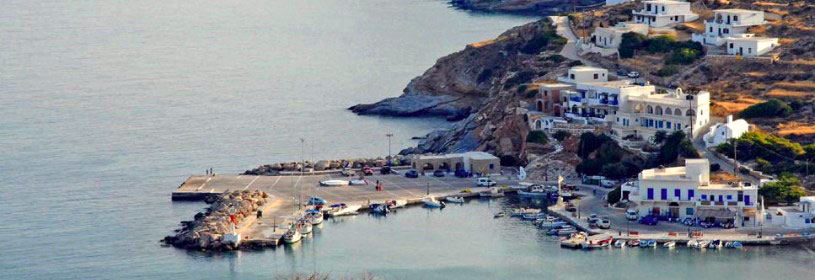
What to do in Sikinos
Don’t come to Sikinos expecting daytime beach parties, water parks and non-stop tourist activity. This is one of the most peaceful and unspoilt islands of the Cycladic archipelago – a place where you come to escape the summer crowds and mayhem which characterise the main resort towns of islands such Mykonos, Ios and Santorini.
Your stay here will consist of lazy days on the beach, leisurely meals in uncrowded tavernas and perhaps a hike or donkey ride to explore the island’s rocky, terraced countryside which is peppered with vineyards, olive and fig trees.
You’ll arrive at Alopronia on the east side of the island and if your accommodation is in the port area, be sure to visit the twin villages of Hora and Kastro which together form the capital of Ios perched high on a ridge overlooking the Aegean. You can make the journey on foot (about an hour) or take the bus which runs regularly to and from Alopronia to the Hora and Kastro on the west side of the island.
Kastro is the larger of the two villages, a lovely place with a maze of lanes, some beautiful old stone-built mansions and a pretty square in the centre, created by Italian soldiers during the occupation of WW2.
While a way some time in one of the kafeneia (coffee shops) or buy some of the locally produced fragrant honey. Local crafts make ideal gifts to take home – folk art, ceramics, wood carved objects and beautiful embroidery are all on sale in the town’s small selection of gift shops.
Medieval Hora is the older quarter where you can visit the Folk Museum, housed in the private home of a Greek-American collector. An old olive press is the main item of interest among the various local domestic and agricultural curiosities on display here.
The crumbling fortified monastery of Moni Zoodohou Pigis dominates the town from its hilltop position and houses some religious icons by the 18th century Cycladic master Skordilis. The villagers used to take refuge from pirate raids here until the monastery was abandoned in the 19th century.
The main place of interest outside the town is Episkopi, about an hour’s walk or mule ride through the olive groves to the south west of Hora (or there’s a new road which will get you there in a few minutes.
In the north east corner of the island lies Paleokastro, the remains of an ancient fortress. While it may not be as popular as some of its neighboring islands, Sikinos offers a unique and authentic Greek experience.
Explore Chora
The main village of Sikinos, Chora, is a typical Cycladic settlement with narrow alleys, whitewashed houses, and stunning views of the Aegean Sea. Take a leisurely stroll through the village, visit the Church of Pantanassa, and enjoy the peaceful atmosphere.
Visit the Monastery of Zoodochos Pigi
Located near Chora, the Monastery of Zoodochos Pigi is a beautiful religious site with a picturesque courtyard and a small museum. Explore the monastery’s grounds, admire the Byzantine architecture, and soak in the spiritual ambiance.
Hike to Episkopi
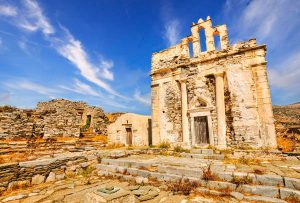
Archaeologists who originally excavated the site in the 19th century believed it to be the remains of a temple dedicated to Apollo but it’s now thought to have been a mausoleum dating back to the 3rd century AD.
It was converted into a Byzantine church in the 7th century and turned into a monastery in the 17th century. Climb to the precipice just to the south of the monastery for spectacular views of the island and sea.
Relax on the Beaches
Sikinos has several lovely beaches where you can unwind and soak up the sun. Agios Georgios, Agios Panteleimonas, and Dialiskari are among the popular options. These beaches offer crystal-clear waters, golden sand, and a tranquil atmosphere, perfect for a refreshing swim or sunbathing session.
Taste Local Cuisine
Indulge in the delicious flavors of Sikinos by sampling the island’s traditional cuisine. Visit local taverns and restaurants to savor fresh seafood dishes, Greek mezes (appetizers), and regional specialties. Don’t miss the opportunity to pair your meal with a glass of local wine, as Sikinos has its own small-scale wine production.
Experience Local Festivals
If you visit Sikinos during the summer months, you might have the chance to attend one of the island’s traditional festivals. These events, such as the Feast of Panagia Pantanassa in August, offer a glimpse into the island’s cultural heritage, featuring music, dance, local delicacies, and a vibrant atmosphere.
Take a Boat Tour
Explore the coastline of Sikinos and discover its hidden gems by taking a boat tour. You can visit secluded coves, swim in pristine waters, and admire the island’s rugged cliffs from the sea. Boat tours often include stops at neighboring islands, allowing you to further explore the Cyclades.
Where to Stay
Although the island is relatively small, there are a few places to stay that provide comfortable accommodations.
Alopronia is the main port of Sikinos and the most popular area for visitors to stay. It offers a variety of accommodation options, including hotels and guesthouses. Staying here provides easy access to the port, as well as beautiful views of the sea.
Chora is the capital village of Sikinos and is located inland, nestled on a hill. This picturesque village features traditional Cycladic architecture, narrow streets, and stunning views. While there are limited accommodation options in Chora, staying here offers a more authentic experience and a chance to immerse yourself in the island’s local culture.
Beaches
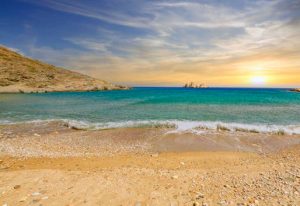
One of the popular beaches on Sikinos is Alopronia, which is also the island’s main port. It features a long sandy beach with crystal-clear waters, making it an ideal spot for swimming and sunbathing. The beach is lined with tavernas and cafes, offering a convenient place to relax and enjoy the surrounding beauty.
Kampos is another picturesque beach on Sikinos, known for its unique landscape. Here, you’ll find a combination of sand and pebbles, surrounded by dramatic cliffs and stunning rock formations. Kampos offers a more secluded atmosphere, making it perfect for those seeking privacy and solitude.
For those who prefer a more adventurous beach experience, Agios Georgios is a popular choice. It is located on the northern part of the island and requires a hike to reach. The effort is well worth it, as Agios Georgios rewards visitors with its breathtaking views and crystal-clear waters. The beach is relatively untouched and provides a sense of serenity amidst nature.
Another notable beach on Sikinos is Dialiskari, located on the southern part of the island. It offers a combination of sand and pebbles, surrounded by cliffs that create a sheltered bay. Dialiskari is known for its calm and shallow waters, making it ideal for families with children.
Sikinos also boasts numerous hidden gems, such as small secluded coves and inlets that can be discovered while exploring the island. These hidden beaches offer a sense of adventure and the chance to escape the crowds, immersing yourself in the untouched beauty of Sikinos.
Culture and local traditions
Sikinos’ culture and local traditions are deeply rooted in its history and island way of life. Embracing the island’s customs, participating in festivals, and exploring its natural beauty will offer a memorable and authentic experience of Sikinos’ cultural heritage.
Traditional Architecture
Sikinos features traditional Cycladic architecture with white-washed houses, narrow alleys, and picturesque villages. The island’s main village, Chora, is a prime example of this architectural style, with its charming streets and blue-domed churches.
Wine Production
Sikinos has a long-standing tradition of winemaking, dating back to ancient times. The island is known for producing excellent wine, particularly the dry white wine variety called “fokiano.” Visitors can explore local vineyards, learn about the winemaking process, and sample the island’s unique wines.
Religious Festivals
Religious festivals and celebrations are an integral part of Sikinos’ cultural fabric. The island has several churches and chapels, each with its own patron saint. Festivals are held throughout the year to honor these saints, featuring processions, traditional music, dancing, and feasting. One notable festival is the celebration of the Dormition of the Virgin Mary on August 15th.
Traditional Music and Dance
Sikinos has a rich musical heritage, and traditional music and dance play a significant role in local celebrations. Folk dances such as the syrtos and kalamatianos are performed during festivals and weddings, accompanied by traditional musical instruments like the bouzouki, violin, and lute.
Gastronomy
Sikinos offers a variety of traditional Cycladic dishes that reflect the island’s culinary heritage. Local specialties include dishes like revithada (chickpea stew), sun-dried tomatoes, locally produced honey, and cheese. Fresh seafood is also popular, as Sikinos is surrounded by the Aegean Sea.
Handicrafts and Arts
Sikinos has a small but vibrant arts and crafts scene. Local artisans create pottery, ceramics, and handwoven textiles using traditional techniques. Visitors can find unique handmade items that reflect the island’s artistic traditions and take home one-of-a-kind souvenirs.
Nightlife
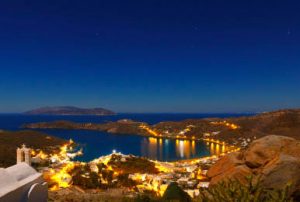
In the main town of Sikinos, called Chora, you’ll find a few tavernas and cafes where you can enjoy a leisurely meal or a drink in the evening. These establishments often have outdoor seating areas where you can soak up the atmosphere and enjoy beautiful views of the Aegean Sea.
Some of the accommodations on the island also have bars or lounges where you can unwind with a refreshing drink. These venues usually cater to the guests staying at the respective hotels or guesthouses.
Although Sikinos may not offer a bustling nightlife, it compensates with its natural beauty, picturesque villages, and stunning beaches. It’s a place where you can relax, connect with nature, and enjoy a peaceful vacation away from the crowds.
Where to eat
While the island may not have a wide variety of dining options compared to larger tourist destinations, there are still several places where you can enjoy delicious meals. When visiting Sikinos, be sure to explore the local cuisine and try traditional dishes like fava (split pea puree), sun-dried tomatoes, and local cheeses, which are often served in various tavernas across the island.
Τaverna Trata
Located in the picturesque village of Kastro, Τaverna Trata offers traditional Greek cuisine with a focus on fresh seafood. The restaurant has a cozy atmosphere and a terrace with panoramic views of the Aegean Sea.
To Kapileio tou Babi
Situated in the village of Alopronia, this family-run taverna is known for its warm hospitality and homemade dishes. The menu features Greek specialties, including moussaka, souvlaki, and stuffed vegetables.
Τaverna Ilias
Located in the village of Chora, Τaverna Ilias is a popular choice among locals and visitors alike. The restaurant offers a variety of Greek and Mediterranean dishes, and its outdoor seating area provides a lovely view of the island’s landscape.
To Steki tis Tinas
Situated in the village of Kastro, this cozy taverna is known for its traditional recipes and warm atmosphere. It serves a range of Greek dishes, including grilled meats, fresh salads, and local cheeses.
Τaverna Sikinos
Located in Alopronia, Τaverna Sikinos is a waterfront restaurant offering a diverse menu of Greek and Mediterranean cuisine. From seafood to vegetarian options, there’s something for everyone to enjoy while taking in the sea views.
How to get to Sikinos
To get to Sikinos, you have a few different transportation options depending on your starting location. Here are some common routes:
By Ferry
Athens to Sikinos: From Athens, you can take a ferry from the port of Piraeus. The ferry journey to Sikinos usually involves a stop at other islands along the way, such as Serifos or Sifnos. Ferry schedules and availability may vary, so it’s recommended to check with the ferry companies for the most up-to-date information.
Other Islands to Sikinos: If you are already on another nearby Greek island, you can look for ferry connections to Sikinos. Islands like Santorini, Mykonos, or Naxos often have ferry services to Sikinos, but the availability may depend on the season.
By Air
There is no airport on Sikinos, so you cannot fly directly to the island. However, you can consider flying to nearby airports, such as Santorini (Thira) Airport or Mykonos Island National Airport, and then take a ferry from there to Sikinos.
After arriving at Santorini or Mykonos, you can take a ferry from the respective ports to Sikinos. Ferry schedules can change, so it’s advisable to check the timetables and availability in advance.
It’s important to note that ferry schedules can vary depending on the season, weather conditions, and other factors. Therefore, it’s recommended to check the ferry companies’ websites or contact them directly to ensure the availability of transportation to Sikinos.
Useful Telephones
Sikinos Port Authority: +30 22860 51121
You can inquire about ferry schedules, ticket information, and other port-related inquiries.)
Sikinos Medical Center: +30 22860 51211.
In case of any medical emergencies or health-related concerns, you can contact the medical center.)
Sikinos Police Station: +30 22860 51222
If you need to report any incidents or require assistance from the local police, you can contact them using this number.)
Municipality of Sikinos: +30 22860 51238.
For any administrative or local government-related queries, you can reach out to the municipality.)
